| This is an English version of an article "Kościuszko i jego polonezy" published by Puls Polonii on 28th January 2006.
We wish to announce far and wide, that the Polish and United States hero, General Tadeusz Kosciuszko, great fighter for human rights, freedom, independence and democracy, was also a talented artist: he drew, painted, and also composed music. He composed 2 polonaises and a waltz.
To listen to his polonaise, please click here. Polonaise C Major
With pride and joy, we present the polonaise, recorded in Sydney by the excellent harpsichordist Monika Kornel, and released (with two other pieces) on a CD sponsored by Puls Polonii. We do write about Monika Kornel in the Artists' Profile section of Puls Polonii. See article "Monika i Wojtek Kornelowie" of May 28th, 2005 in Sylwetki Twórców.
We hope that this recording will help the Australian Polish community win the battle to retain the original name of the highest mountain peak in this country, ie, the mountain peak named by Sir Paul Edmund Strzelecki after our great hero Tadeusz Kosciuszko.
Kosciuszko's musical pieces were performed for the first time in Australia by Monika Kornel on Saturday 20 March 2004 in the Verbruggen Hall in the Sydney Conservatorium of Music. This was the second concert in the series "8 Centuries of Polish Music".
Monika Kornel found out about Kosciuszko's compositions from Marek Wakarecy, Director of the Torun Chamber Orchestra in Poland, who subsequently was good enough to send her the scores of these pieces.
Over 5 years ago, the Mayor of Tumbarumba, a town at the foothills of the Australian Snowy Mountains, stated that the name of the highest Australian mountain should be changed.
He said, in a TV interview, that the Poles should give up this name "because Kosciuszko never set foot on Australian soil, and Strzelecki deceived us..."
This matter re-emerged 4 years later, as part of moves to unify Australians, through trying to "Aboriginalise" as much as possible. Last year, work began on a revised Plan of Management for the Kosciuszko National Park. The group of people working on the Plan was required to address the issue of whether or not the current name is appropriate, or whether it should be changed, or a dual name introduced.
(From the article by Dr. J Rygielski " 5 years of debate over the name of the mountain peak Kosciuszko," Polish Weekly, 8 June 2005.)
The musical score for the 3 pieces is from the Museum of Tadeusz Kosciuszko, in Solothurn, Switzerland. The Vice Curator of this museum, Dr. Jan Konopka, together with his wife, Suzanne Leisi Konopka, wrote about the history of the music in an article entitled "The musical compositions of Tadeusz Kosciuszko", in "Our Newspaper, No. 4/2004.
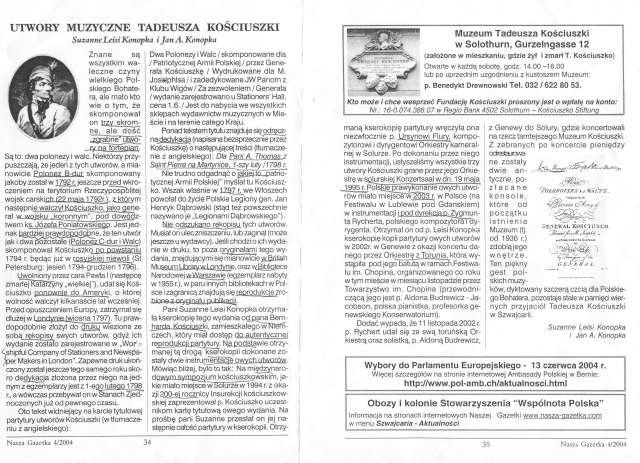
From "Nasza gazetka" no 4/2004 |
The museum is located in the house where Kosciuszko lived for 2 years, and died. The museum was established in 1936, as a result of efforts by the Polish and Swiss Governments. The museum is overseen by the Kosciuszko Society.
In 1994, during the bi-centenary year of the Kosciuszko Uprising, celebrations were held at the Solothurn Museum. The celebrations were attended by two gentlemen descendants of Kosciuszko bringing with them the title page of the musical scores!
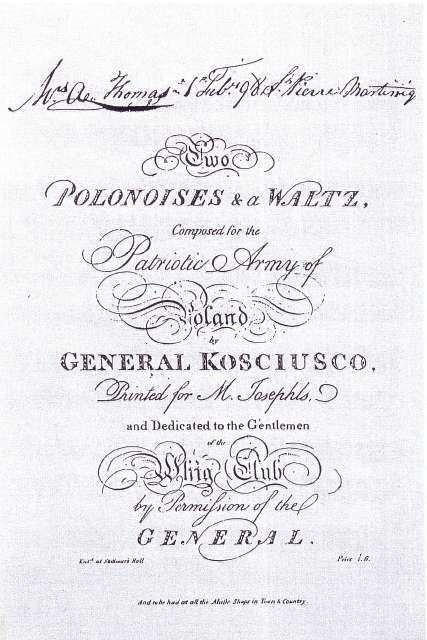
Dedicated to the patriotic army of Poland.Courtesy of The Kosciuszko Museum, Solothurn.[/i[ |
Strictly speaking, the documents were a photocopy of the original. Dr Jan Konopka's wife, Suzanne, asked them for the whole musical score. She subsequently gave this to the Director of the Solothurn Chamber Orchestra, who created an orchestral arrangement from the solo pieces.
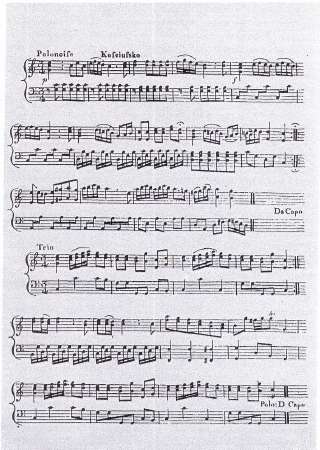
Polonaise by T.Kosciuszko.[i]Courtesy of the Kosciuszko Museum, Solothurn |
We received a copy of the musical score from the Vice Curator of the Kosciuszko Museum in Solothurn.
And so, this is how in 1996, in Solothurn, Kosciuszko's musical compositions were first performed. Was it the Grand Premier? Possibly .. We really do not know if these pieces were ever played during the lifetime of Kosciuszko, or, after his death. It seems though, that the concert in Solothurn, was at least the Grand Premier of the orchestral version.
Dr Jan Konopka also told us that the Director of the Torun Symphonic Orchestra in Poland, Mr Rychter, expressed interest in the music. We do know that as a result of this interest, further orchestral performances of Kosciuszko's music, were given in 2004.
When and in what circumstances did Kosciuszko compose his musical pieces?
This is not known. We can speculate that they were composed while he was held in a Tsarist prison. After a year of internment at the Fort of Saints Peter and Paul, he was transferred to the marble palace of Prince G Orlowa in St Petersburg. Perhaps it was there that he had access to the harpsichord ?
He was given a whole team of servants, who carried the prisoner around on a lounge chair on wheels (...)
They satisfied his every whim, including a metal lathe (...) from then on one of his most pleasurable pastimes was making cigar holders, cups, sugarbowls, vases, tobacco boxes etc.
It is less likely that he composed the music in London, where he found himself after being freed by Tsar Peter I, on his way to America.
We know that the music was published in London and sold for 1L 6p. The originals of the music do not seem, however, to have survived, although we do know for certain that they were published in London.
We only have a copy. From the information on the first page of the copy, we know that the pieces were composed to honour the "patriotic army of Poland."
There is also a dedication to a Lady Thomas of Martinique. There is a date next to the dedication - 1 February 1798. And so, therefore, the dedication was written during his second visit to the United States.
We appeal to American historians - could we try and discover who was Lady Thomas? And also, who was Lady Moore, whose portrait, painted by Tadeusz Kosciuszko, has also survived.
In the museum in Solothurn, there is a lithographic portrait of Thomas Jefferson, painted by Tadeusz Kosciuszko.
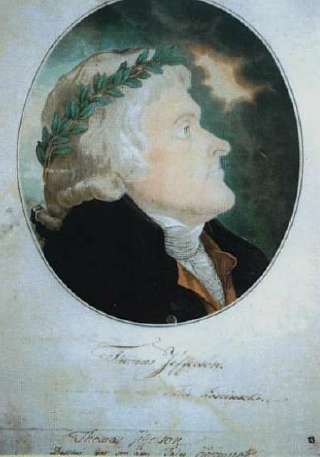
Thomas Jefferson. Portrait by T.Kosciuszko.Courtesy of The Kosciuszko Museum in Solothurn, Switzerland. |
There are also coloured portraits of the daughters of F K Zeltner, the owner of the house in which Kosciuszko spent the last years of his life. Emilka Zeltner seems to have been a true favourite of Kosciuszko.
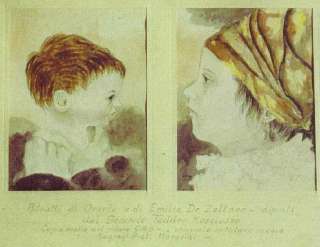
Ursula and Emily Zeltner as painted by Tadeusz Kosciuszko.Courtesy of Jan Konopka, The Kosciuszko Museum in Solothurn. |
It seems that Kosciuszko was keen to play the harpsichord, even in the last years of his life. One year before his death, he wrote this to General Francis Paszkowski:
"Would you be good enough to send me some of the latest, high quality, Italian and French arias for the harpsichord."
Excerpts are from the book by Bartholomew Szyndler "Tadeusz Kosciuszko 1746 - 1817", published by Bellona, Warszawa, 1991.
This article is based on Ernestyna Skurjat's SBS Radio interviews with dr Jan Konopka & Monika Kornel 2005. Translated by Urszula Lang 2006.
| 

